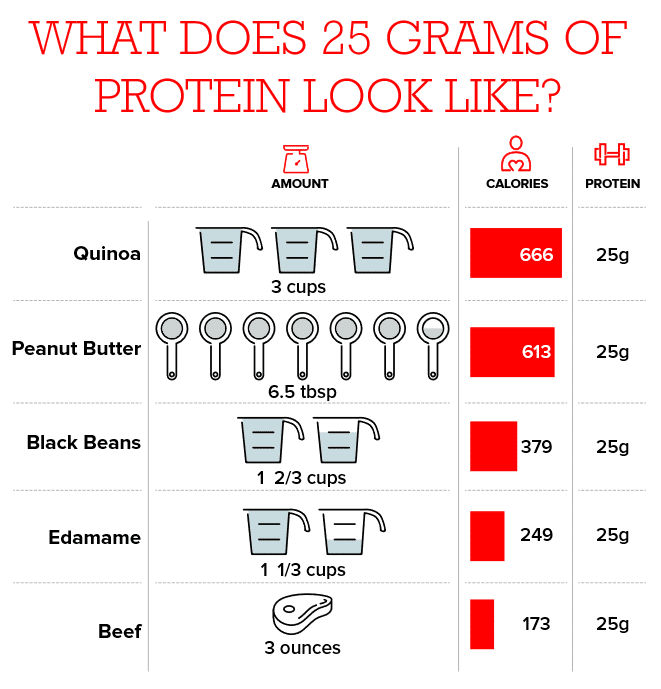Introduction
Not all proteins are created equal. Some have higher protein quality than others. This NutriWiki will explain exactly which proteins are of higher quality than others.

Summary
Animal sources of protein are generally considered to have higher protein quality when compared to plant proteins. Whey protein is often seen as the “gold standard” of protein quality. If you are on a plant-based diet, you should get your proteins from a wide variety of sources, that combine together to form a complete amino acid profile.
There is no need to supplement with protein powder if you are able to get your daily protein intake from whole food sources.
Discussion
There are several ways to determine the quality of protein, however, the most commonly used assessment is the Protein Digestibility-Corrected Amino Acid Score (PDCAAS) [1]. Thus protein will be gauged on its ability to provide essential amino acids to an individual. Based on this assessment we have provided a short table showing different food sources and their PDCAAS (1 is highest & best):
| Protein Source | PDCAAS |
|---|---|
| Milk | 1.00 |
| Whey | 1.00 |
| Casein | 1.00 |
| Egg | 1.00 |
| Soy | 1.00 |
| Beef | 0.92 |
| Black Beans | 0.75 |
| Peanuts | 0.52 |
| Wheat Gluten | 0.25 |
Dairy Protein
While drinking milk will provide you with a high quality protein, it may not be the most practical protein source due to the other macronutrients in milk (e.g. fats and carbohydrates). Therefore, the most common milk proteins are actually bi-products of commercial milk production, whey & casein.
Whey protein is typically taken post-workout due to being a fast-acting protein. This is because whey protein can be broken down and absorbed faster than most other proteins. This allows for a spike in muscle protein synthesis that will return to baseline within 300 minutes [2]. Casein is a slower digested protein that is typically taken at night to spread out the protein absorption during sleep [3]. Casein causes a spike in muscle protein synthesis that is still elevated beyond 300 minutes.
What type of protein is best post-workout? While that can vary based on each individuals schedule, protein timing, & diet, there is a general recommendation/guideline. Studies conducted in 2004 and 2010 ranked different types of protein based on blood plasma levels of essential amino acids (EAAs), branch chain amino acids (BCAAs), & insulin [4,5]. Their findings in order of most effective to least effective:
Hydrolyzed whey > Non-hydrolyzed whey > Hydrolyzed casein > Non-hydrolyzed casein > Hydrolyzed soy > Non-hydrolyzed soy
Note that at dosages higher that 30g of protein, hydrolyzed whey does not increase plasma concentrations of BCAAs more than non-hydrolyzed whey.
Plant Protein
Plant proteins are consumed by everyone who eats carbohydrates. For example 100g of oatmeal has 12.64g of protein and 200g of white potatoes has 3.36g of protein.
Now not all proteins are created equally. There is an optimal essential amino profile for a protein to be considered complete:
| Essential Amino Acid | mg/g of Protein |
|---|---|
| Tryptophan | 7 |
| Threonine | 27 |
| Isoleucine | 25 |
| Leucine | 55 |
| Lysine | 51 |
| Methionine+Cystine | 25 |
| Phenylalanine+Tyrosine | 47 |
| Valine | 32 |
| Histidine | 18 |
Plants sources such as potatoes, soy, chickpeas, black beans, lupin beans, pistachios, cashews, & cauliflower are all sources of complete proteins, meaning they contain all of the above amino acids.
Plant sources like yellow pea & brown rice are often missing one or more of the essential amino acids listed above. When following a plant-based diet, it is important to obtain protein from a wide variety of source to ensure a complete amino acid profile.
References
- The Protein Digestibility–Corrected Amino Acid Score.
- Tang, JE (Sep 2009). “Ingestion of whey hydrolysate, casein, or soy protein isolate: effects on mixed muscle protein synthesis at rest and following resistance exercise in young men.”. J Appl Physiol. 107(3): 987–992.
- Smith-Ryan, Abbie E.; Antonio, Jose (2013). Sports Nutrition & Performance Enhancing Supplements. Ronkonkoma, NY: Linus Learning. p. 33, 41. ISBN 978-1-60797-339-3.
- Hoffman, Jay (June 2004). “PROTEIN – WHICH IS BEST” (PDF). Journal of Sports Science and Medicine (3): 118–130.
- Morifuji, Masashi (2010). “Comparison of Different Sources and Degrees of Hydrolysis of Dietary Protein: Effect on Plasma Amino Acids, Dipeptides, and Insulin Responses in Human Subjects”. J. Agric. Food Chem. 58 (15): 8788–8797.
